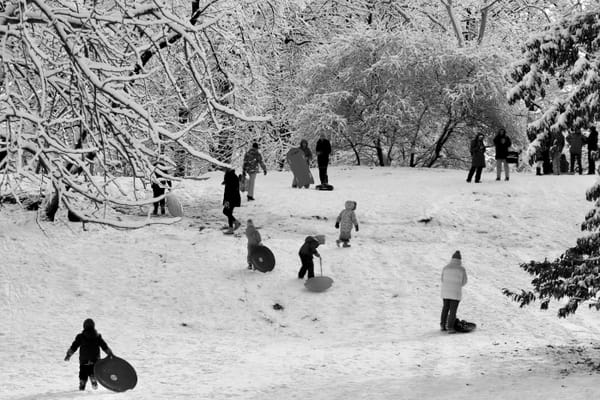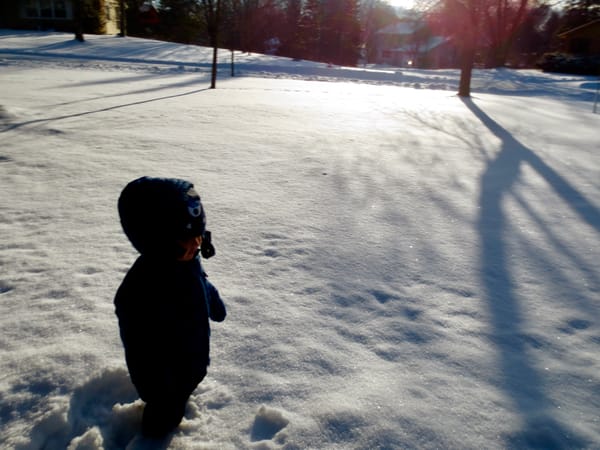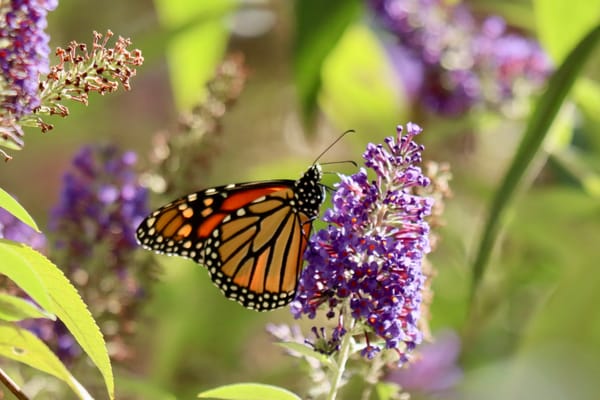Lessons in Leadership
Finding strength in curiosity and care
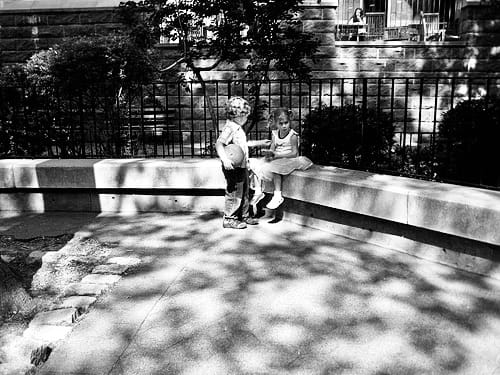
“My heart is moved by all I cannot save:
so much has been destroyed
I have to cast my lot with those
who age after age, perversely,
with no extraordinary power,
reconstitute the world.”
~Adrienne Rich
I’ve been thinking a lot about leadership this week. It’s been hard not to, as we’ve moved through a punishing news cycle among so many such cycles, filled with questions, globally, about who is most suited to lead and how much power we ought to give over to individuals. Specifically, though, I’ve been thinking about the qualities that we are drawn to as signifiers of leadership, which traits we hand power over to with seeming ease and which are more difficult to identify and lift up.
As a teacher, I’ve spent many years observing the push and pull of power among children, as they strive to locate their own voices, as well as their role within their community and the wider world. So much of school life is dominated by the developmental drama of experimenting with power.
Children work constantly to understand the structures of their relationship with adult authority and to crack the code of social authority among their peers. Most of us probably have more vivid memories of these experiences and lessons than of the academic content that is the central function of school—the exhilaration of the times when we found ourselves at the center of the group, the crush of being rejected, the tension of choosing to stand up for a friend and risking putting ourselves on the outside along with them, or remaining within the seemingly safe glow of acceptance. These emotion laden memories are the ones that embed themselves in our minds long after we’ve forgotten the algorithms and poetic forms we were supposed to be memorizing.
Often the qualities children are drawn to are similar to those that easily capture our attention and loyalty as adults. Though we may like to think that we are more rational and intentional in deciding whom we will follow, we are frequently enticed by instinct over conscientiousness, just as children are. Social acceptance is at the core of our survival instincts. On a basic biological level, our brains recognize the feeling of being taken into the group as indicative of survival, while exile registers as vulnerability in its purest form, neurologically akin to physical injury. So we are enticed by those who project strength, confidence, and certitude, because we sense our survival in their power over the group, and we instinctively tuck ourselves within the safety of the pack that coalesces around these traits.
Children are attracted to these qualities as well, to the peer who seems to possess a charisma that allows them to summon a playground game and assign roles without objection. Sometimes these take-charge qualities are coupled with an exuberance for social connection and a genuine more-the-merrier spirit. This energy can become contagious, sparking an exhilarating and inclusive group ethos. Sometimes, though, a powerful voice in the classroom emerges instead from the more complicated feelings of possessiveness or a need for control. The same confidence might be projected, but the difference in intent can lead to more fraught dynamics.
As the educator and author Jane Katch posits, children often instinctively try to distance themselves from feelings that are uncomfortable by falling into alignment with apparent strength and pushing those who show insecurity to the edges. Most often, Katch says, the qualities children seek to cast onto others and avoid in themselves are fear and “babyishness.” To do this, children will sometimes attach themselves to a peer who’s bravado comes across as forceful and powerful, and they will, in turn, reject those whose fears or differences threaten to crack the tenuous alliances that provide power through proximity.
The temptation to gravitate to bravado in an effort to erase our own fears and insecurities is a very natural human inclination. However, as strong as this temptation may be, this is not always how social dynamics play out in the classroom. Social hierarchies are complex, and there are other compelling characteristics of childhood that can just as easily become dominant in the process of weaving the social web. Most notably children’s strong capacities for curiosity and care can and often do win out.
The world can feel very big and overwhelming to children, so it is particularly understandable that they would sometimes seek out the glow of power, which can create an impression of security. But children are also driven by intense curiosity. As Alison Gopnik notes, they are “designed to learn,” so they feel compelled to attend to anything and everything of potential interest. This is why young children often seem so easily distracted. Without the very strong drive curiosity provides, it would not be possible for children to learn and develop at such a rapid pace. Their growth demands constant inquisitiveness.
We see the impact of this intense curiosity in their brain development. Children form more than a million neural connections every second. A three-year-old’s brain is twice as active as an adult’s. So, as much as authority and security are inherently compelling, curiosity can overshadow almost every other instinct for a child, including which peers they seek out and how they identify authority.
Children are also empathetic from their earliest days, and research shows they may even have a particularly strong affinity for victims—a wrench in the notion that social power is paramount! While they are capable of being lured by exclusion and clout, just as we all are, they are also capable of navigating their social puzzles with compassion and generosity and aligning themselves with vulnerability. When their intense curiosity merges with their ability to show care, the choices children make about whose lead to follow and which ideas to pursue can turn expected hierarchies on their head.
Given the vividness with which children’s social experimentation can play itself out in the classroom, I often think about the laboratory of the classroom as I wonder what we adults might do and what we are capable of. And when I think about the qualities that can draw us to leadership in particular, I am pulled back to a year in my own classroom when an especially unexpected leader emerged out of the powerful intersection between curiosity and care.

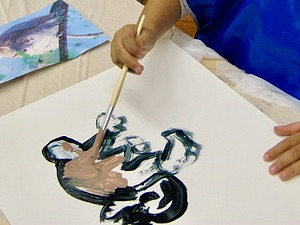
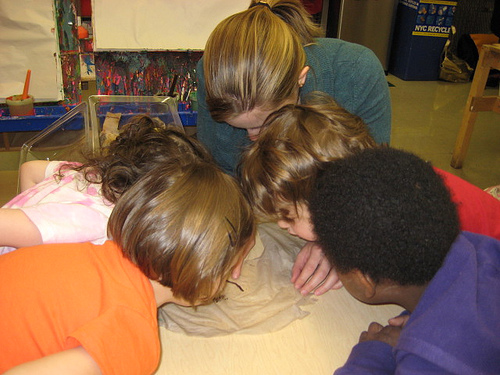
As fall took hold in this particular school year, the children became fascinated by the maple pods that swirled down from the canopy of trees above and blanketed our playground. Most of the children would spend their outdoor time focused on the soil, collecting these treasures from among the dry leaves. As they looked down, however, one child became entranced, instead, with the branches above.
At first, we weren’t sure what had captured his attention as he gazed upward each day, but it gradually became apparent that he was intently observing the squirrels, as they leapt from branch to branch. In time, his sharp eye began to draw other children to his side and into his observations. They started to abandon their maple pod collections, gathering, instead, around this boy whenever we went outside, spotting squirrels together until nearly the whole class was fixated on tracking their frenetic movements above.
Eventually, their observations grew into an extended curriculum, in which the children watched squirrels, read about squirrels, painted squirrels, took walks gathering evidence of the squirrels’ food collection and nest building, and attempted to photograph them before they dashed up a tree trunk and out of sight. The little boy who first drew the other children into becoming squirrel scientists continued to serve as the leader of their investigation, though the fascination became collective. They knew that his keen eye could be counted upon to spot the slightest movement in the branches, and they looked to him and followed his gaze.
In remembering this school year, what remains most profound about the learning experience of the group is not the extent to which the children’s representational drawing and painting skills developed as they created images of squirrels at the easel, or the investigative capacities that emerged as they took clipboards and magnifying glasses outside, or the many counting games we played with the acorn tops they found and the squirrel puppets we kept in the meeting area. The most profound aspect of this memory for me is the fact that the little boy, who was in every way the leader of this research project and the identified expert among his peers, also happened to be a child who rarely spoke out loud at school.
We knew from his deeply loving parents that he spoke well and easily at home, but speaking at school paralyzed him. For most of the year, we rarely heard his voice, and when we did it was usually an almost inaudible whisper to a trusted friend or adult, followed by a quick wide-eyed glance around, as he checked to see who else might have heard him.
In addition to his silence, this little boy was different in many other ways as well. His family structure and his racial identity were different from the majority of his peers, and he’d had a difficult start in life with no easy parallel among any of the other children. He had understandable reason to feel anxious and reluctant to share his voice, let alone put himself at the center of the group. I think, in his shoes, we might all have kept our lips pursed in self-protection. And yet, with a simple gesture upward he could command his friends' attention.
It would have been easy for the children to disregard this boy or even make him a focus of antagonization—to see his fear, his differences, and his tentativeness as emblems of the very features they did not want to acknowledge in themselves. But, instead, the opposite happened. His curiosity about the creatures leaping and chattering above sparked their own curiosity and they couldn’t help but be drawn into his company. His quick eye became a highly valued skill that mattered more to the group’s exploration and pursuit of knowledge than his ability to put words to his observations. And, spurred by their curiosity, their empathy was also activated, as the children not only followed his lead but became his voice. They leaned in close when he had something to say, however quiet, and they attended vigilantly to his nonverbal cues, letting the adults know when there was something they thought he needed to communicate.
An important element of the process that placed this unlikely leader at the center of our classroom was the fact that it did not happen instantly. The recognition of his capacity for leadership was gradual and grew out of just a few children initially coming to his side to try to determine what had him so fascinated high above their heads. A few children were willing to put their buckets of maple pods aside and patiently follow his eyes until they saw what he saw. Those children then rallied the attention of more children and of the adults, until eventually we were all looking up instead of down.
I am certain that the children in this particular class extended their academic skills more fully than in most other years, because they were so invested in capturing squirrel data, gathering information, and finding ways to express and represent their learning. However, I am also sure that their notions of who has knowledge, power, and the capacity for leadership were shaped by their year following a brilliant and unlikely gaze up into the trees. And I hope that his sense of his own place in the world was transformed as well, even in small ways, as he was slowly and quietly placed at the center by his peers, who recognized his strengths.
These lessons in leadership, as well as in diversity, dignity, and the process of acquiring understanding, could never have been found in a fall curriculum box, waiting on the shelf to be pulled down each year, inevitably placing the teacher’s voice, knowledge, and rituals at the forefront of our work. And they could not have been found in our most rational and educated adult guesses about who would summon engagement and cohesion in the classroom. These lessons could only be found by deeply curious children following the focused eyes of a quiet little boy into the treetops.
It is easy to be swept up by the loud, powerful, dominating voices that help us silence our own vulnerabilities and insecurities. It is harder to be patient and still and to seek out compelling ideas, even when they may come from unexpected places—to find leaders we didn't even know were there, waiting to show us a better way. Doing this requires the courage to put curiosity and compassion above ego, anxiety, and expectation.
In our very anxious time, I think we would do well to find it within ourselves to summon the qualities that allowed a group of three-year-old children to see value in learning from and following their curiosity and compassion instead of their fear, wherever that may lead, and to urge those around us to do the same, as the first children to put down their maple pod buckets did.
Wishing you an abundance of curiosity and care,
Alicia
If you think someone else in your life might enjoy reading Notes on Hope, please share. It’s always easier to hold onto hope when we are not doing it alone.


